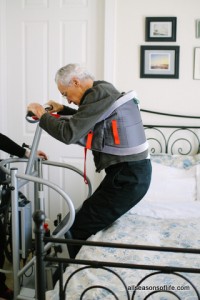Stroke,Parkinson’s, Alzheimer’s, a broken hip or just old fashioned weakness are all reasons for possible loss of mobility for the elderly. Whatever the reason, the title of “non-ambulatory” very often goes hand in hand with the decision to move to a care facility.
Why is it so important to prevent falls? Is it that big of a deal?
Here’s some crazy statistics:
- Falls are the number one cause of death due to injury among the elderly.
- Falls account for 25% of all hospital admissions
-
Falls account for 40% of all nursing home admissions
- 40% of those admitted do not return to independent living
- 25% die within a year
These are staggering numbers! Who would have thought that a fall could be that destructive?
Imagine this difficult, but very common scenario.
Joe has dementia. His loss of memory has been slow and his family has worked hard to enable him to stay at home as long as possible. One day Joe falls and breaks his hip while walking to the restroom in the middle of the night. After going through rehab, the doctor tells Joe and his family that Joe needs 24 hour care.
Joe’s family finds a very pretty facility with lots of wonderful people. But there’s a problem. When Joe has to go, Joe has to go. Since Joe has dementia, he doesn’t realize that he not only isn’t home, but that he is recovering from a broken hip. He jumps out of bed and proceeds to collapse under the weight of his first step. No matter how often the nice people at the facility check in on him, it just takes a few minutes of being alone. Joe’s dementia doesn’t allow him to realize his great danger of falling. Within a couple of days, Joe is back in the hospital with a broken arm and a very badly bruised face.
This is a very sad scenario. Joe’s case is not uncommon, and it doesn’t only happen with a broken hip. He could have had a stroke, and now he doesn’t realize that his right leg doesn’t respond. Whatever the cause, fall prevention can get very tricky and there’s only one solution.
In our tech saturated world, every facility has access to an array of fall prevention tools. There are call buttons, mattress and bedside pressure sensing mats, motion detectors and more. All of these tools can help a facility be notified when Joe is about to fall, but even they are not enough. The biggest security against falls is a care team large enough to respond to Joe getting up. If the motion detector is tripped and goes on and on sounding the alarm, but now one comes, Joe will fall.
When you visit facilities, ask them what their staff to resident ratio is? Talk to them about what measures they have taken to prevent falls. Realize that falls are never 100% preventable, we can’t take gravity out of the picture. But you can choose a place that is amply staffed and able to respond to your loved one’s mobility needs.
This concludes our four part series. If you have any questions at all, please contact us!


